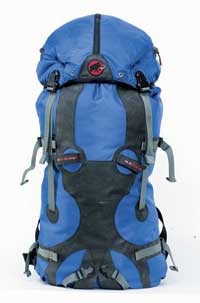|
| |
|
 |
 |
 |
|
|
|
Gearing Up For Winter - No. 245
Reviews by Ted Callahan, Luke Laeser, Craig Dostie,
Majka Burhardt, Matt Stanley, and Jeff Hollenbaugh
|

|
Mammut Ice 45 pack
Carrying around all the pointy, sharp stuff necessary for ice climbing
requires a well-designed holster. Mammut’s new Ice 45 pack ($165, 2700
cubic inches, three pounds, five ounces) handles the job well. The durable
nylon fabric lasted my entire ‘04-’05 ice season, plus a couple
overstuffed-with-cams Indian Creek trips, without a puncture. (Note:
Screws, crampons, and other pointy objects should never be hastily thrown
into the pack, for the sake of your pack, the pointy objects, and your own
longevity.)
Thanks to Mammut’s new internal-frame, aluminum-tubing “Butterfly System”
suspension, the Ice 45 comfortably carries loads up to 40 pounds. The
pack’s sack is a lightweight, svelte design that eliminates the need to
take the scissors for a trimming mission. Should you need to lighten it
further, however, the waist belt, back pad, and aluminum frame are
removable, dropping the weight to a very trim two pounds, five ounces. The
lid is fixed — it would be nice if it floated for expansion room — and
contains two compartments, one with a key clip, sealed with
water-resistant zippers. The sack’s white interior lining conveniently
brightens up the inside, which helps when you’re digging to find your
stray energy bar that may have settled to the bottom.
The ice specific pack is designed to handily carry both leashed and
ergonomic leashless handles, from the double-stacks of the Petzl Ergo and
Grivel Racing Wing to the more radical dogleg of the Simond Coyote. There
is no crampon attachment, which conveniently negates, in my mind, the need
to cut off a clumsy pocket. It’s better to keep the pointies in a durable,
puncture-proof pouch. Other features include a hydration pouch with
shoulder-mounted tube clip, compression straps, and bungees mounted under
the lid for overloading.
The Ice 45 also fits within requirements for airline carry-on baggage;
don’t, however, use that as an excuse to try waltzing though security with
leashless tools strapped on the outside — you’ll surely be arrested.
— Luke Laeser
Mammut: 800.451.5127, www.mammutusa.com
|
|
The DTS was the first digital beacon on the
market, and it still sets the standard for ease of use. To switch it to
receive mode, just hold the big red button down for a full second. The red
LEDs flash the letters SE, for search, and then you just sweep the entire
path zig-zag style (20-meter strip width) until you pick up a signal. From
there it’s pretty intuitive. Five LEDs show what direction to move, and
the numbers show how far away you are. When you get within three meters,
slow down to pinpoint the closest location. Then dig like mad. In the case
of multiple burials, some of the other beacons have features that help
out. But the bottom line with all beacons is practice, practice, practice.
Several ski resorts that now offer practice ranges for this sort of
exercise. Do it.
— Craig Dostie
Backcountry Access:303.417.1345, www.bcaccess.com
Barryvox/Mammut: 800.451.5127, www.mammutusa.com
|
| |
| |
|